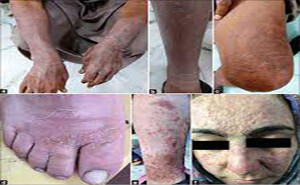Posted by Admin Posts
The prevalence of superficial
fungal infections across the globe is increasing from 20-25%. Superficial
infections are mostly caused by dermatophytes. Depending on the site affected,
the dermatophytes are clinically classified as Tinea capitis (head), Tinea
faciei (face), Tinea barbae (beard), Tinea manus (hand), Tinea corporis (body),
Tinea c...
There has been a significant
increase in the incidence of chronic, relapsing, recurrent cases of superficial
dermatophytosis in India that are also often unresponsive to conventional drugs
and doses of recommended antifungal treatment. Almost 15– 20% of the outpatient
department cases are those of chronic dermatophytosis. Recurrences and relaps...
Mycoses Journal: Published on April 2021Dermatomycoses of zoophilic origin,
especially those caused by Trichophyton mentagrophytes, often pose considerable
therapeutic problems. This is reflected in the growing number of strains of
this species with resistance to terbinafine caused by a mutation in the
squalene epoxidase (SQLE) gene. TAKE HOME...
Infection and Drug Resistance Journal:Tinea is superficial fungal infections typically caused by
dermatophytes.Superficial fungal infections are widespread, with an
estimated worldwide prevalence of 20%–25%, and include tinea pedis (athlete’s
foot), tinea cruris (jock itch), and tinea corporis (ringworm), among othersTopical allylamine (terbinaf...



